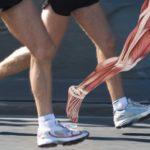Cross Training an Answer to Injury
Cross Training an Answer to Injury
By CEO Robert Forster, PT
Year round training can leave you feeling tired, tight and sore, or even worse, injured. Maybe you feel a lack of motivation or you are having trouble maintaining your body weight.
These are signs that you need to mix it up a bit. That’s where cross-training comes in. Cross-training will not only provide great recovery workouts but also compliment running by strengthening the muscles neglected in your run workouts and help avoid injury by varying the stress on your body.
Cross-training workouts will increase your aerobic base fitness and improve your running performance, while giving your body a break from the repetitive motion of running. Having an alternative cross training workout is also valuable when injury strikes to provide a training modality that will maintain your hard earned fitness.
Many runners feel no other workout will do. They feel there is no workout quite like a good run. Our experience, however, is that once runners try the water they enjoy the variety and find that adding cross-training days to their weekly schedule is helpful in preventing over training, burnout and injury. We have found that water running makes stronger runners. These cross training options have been found to benefit runners most.
Forster WaterPower© Program
ALLYSON FELIX WATERPOWER
Allyson Felix Performs Forster’s WaterPower Workouts to increase fitness, power, and speed, throughout rehabilitation of an ankle injury, and runs fastest 400m in the world post injury.
Aqua jogging is a great form of cross training for runners as it most closely mimics the running movement while providing valuable improvements in fitness. Since water offers six times the resistance of air, water running strengthens the muscles critical to proper running technique.
The hip flexors, abdominals, gluts and upper body muscles all benefit from moving against the resistance provided by water. Most importantly, aqua jogging is impact free, which means your joints will love you for it and it can often be tolerated immediately after almost any injury. Studies have shown that aqua jogging can enable a well-trained runner to maintain running fitness for up to 4-6 weeks when injured.
According to a study published in the Medicine and Sports in Science and Exercise, competitive distance runners maintained running performance using 4 wk of deep water run training as a replacement for on-land training. Using aqua jogging as a cross training method between hard workouts has also been shown in studies to significantly reduces post exertional muscle soreness and aides recovery by reducing the stress hormone Cortisol.
For advanced conditioning, water workouts offer a forgiving environment to perform high intensity intervals and plyometrics with less resulting soreness and quicker recovery time. While submerged, your body experiences pressure exerted by the water around you. This is called hydrostatic pressure and it assists the return of blood from your muscles to the heart and lungs where waste products are expelled and oxygen is picked up to be delivered back to the muscles to make energy. In this way heart rates are lower in the pool than on land for the same level of intensity.
Aqua jogging can be done in the shallow end of the pool with water at chest level or deeper water with a floatation device around your waist. Floatation devices can also be used in the shallow water to further reduce the load on the joints of the lower body to protect injured structures. When running in deep or shallow water your mechanics need to be correct with high knee lifts and strong arm movements. Resistance can be further increased with various devices that can be worn to increase more drag on your limbs as they move through the water.
Forster Physical Therapy and PHASE IV offer instruction in WaterPower Workouts: Call 310.656.8600 for details.
Elliptical Training
Elliptical training also mimics the running movement while avoiding the impact forces experienced with running. On the elliptical machine you can adjust the resistance and stay within the proper heart rate training zones. In one study, researchers concluded that when training volumes and intensities were equivalent on the treadmill and elliptical, physiological adaptations remained relatively the same. So, while the elliptical is not a perfect substitution for running, it will allow you to perform recovery workouts or maintain fitness during time off from running.
Cycling
Stationary cycling, road biking and mountain biking are also great cross training activities. Biking is a great recovery activity as it flushes waste products from the muscle and delivers nutrients and oxygen to help repair the muscles after hard workouts. While the pedaling motion does not simulate the running motion exactly, it works a lot of the same muscles but avoids the impact forces of running. Likewise biking is also a great way to develop advanced aerobic fitness without the wear and tear long runs place on the joints. At Phase IV we advise runners to cross train with biking in the early season to help achieve a good aerobic base of fitness. A decent bike and a good bike fit is all you need to enhance your recovery efforts and improve fitness.
References:
Medicine & Science in Sports & Exercise: May 1997 – Volume 29 – Issue 5 – pp 694-699
Medicine & Science in Sports & Exercise: May 1998 – Volume 30 – Issue 5 – p 169
The Complete Waterpower Workout Book: Lynda Huey and Robert Forster, Random House, 1993








